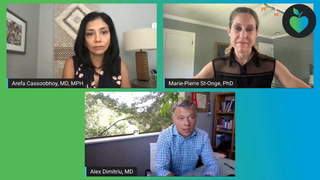How Doctors Diagnose Sleep Apnea — and What to Expect at a Sleep Study

If you snore and make loud gasping noises during sleep, only to wake up in the morning feeling tired, you may have sleep apnea, a common sleep disorder characterized by temporary pauses in breathing.
Here’s what you should know about this screening, including how it works and what the results may reveal.
What Types of Sleep Problems Should You Tell Your Doctor About?

Next up video playing in 10 seconds
Prior to a Sleep Study: Take Stock of Symptoms
If you suspect you have sleep apnea, start by telling your primary care doctor about the symptoms you’re having. Your doctor will likely do three things:
- Obtain a full medical history, including whether you recently gained weight or started taking any new medications
- Conduct a physical exam, including an examination of your mouth and throat
- Order a sleep test
They may also order additional tests, such as an echocardiogram or thyroid function test, to rule out other conditions that may be causing the symptoms.
Some of the questions your doctor may ask you can include:
- How tired do you feel during the day?
- How long do you sleep at night?
- How would you rate the quality of your sleep?
Based on the findings, your doctor may suggest an at-home sleep test or a sleep study (called polysomnography) performed in a sleep lab.

Sleep Test vs. Sleep Study and What to Expect
If your doctor suspects you have obstructive sleep apnea without other serious health conditions, such as heart disease or lung problems, they may prescribe a portable sleep test device to use at home, says Robson Capasso, MD, chief of sleep surgery and a professor of otolaryngology and head and neck surgery at Stanford University School of Medicine in California.
If the test shows that you have sleep apnea, your doctor may be able to prescribe treatment without further testing. But if test results are normal and indicate that you do not have sleep apnea, your doctor may prescribe polysomnography, which is done at a lab, because home monitoring devices aren’t able to detect all cases of sleep apnea, says Dr. Capasso.
- Electroencephalography (EEG) Stuck to your head to track the electrical activity of the brain (brain waves) during the different stages of sleep
- Electrocardiography (EKG OR ECG) Worn on the chest to pick up the electrical activity of the heart
- Electromyogram (EMG) Attached to the face and leg to track muscle movement
- Electrooculography (EOG) Placed around the eyes to detect eye activity
- Respiratory Inductive Plethysmography (RIP) Belt Measures the effort of your breathing by tracking the expansion of your chest and abdomen
- Breathing Sensors Measure how well air flows in and out of your lungs through your mouth and nose
- Pulse Oximeter Placed on an index finger to read your pulse and the oxygen level in your blood
Most sleep centers have comfortable rooms modeled after those in hotels. Usually only one night is needed. You will most likely be asked to arrive a few hours before bedtime.
Your doctors can schedule a follow-up appointment after the sleep study to discuss the results, including whether you have sleep apnea and which treatments might be right for you.
The Takeaway
- Sleep apnea can be diagnosed using an at-home sleep test with a monitor or with a sleep study done in a lab.
- In a lab sleep study, you’ll sleep in a room and wear sensors that monitor your sleep cycles and stages.
- A doctor will interpret the results of the sleep study to determine whether you have sleep apnea and which treatments, if any, may be helpful.
- The Dangers of Uncontrolled Sleep Apnea. John Hopkins Medicine.
- Sleep Apnea. Cleveland Clinic. January 15, 2025.
- What to Know About an At-Home Sleep Test. Johns Hopkins Medicine.
- Blaivis AJ et al. Polysomnography. MedlinePlus. May 3, 2024.
- Sleep Study (Polysmonography). Cleveland Clinic. February 10, 2023.

Abhinav Singh, MD
Medical Reviewer
Abhinav Singh, MD, is a board-certified sleep medicine specialist and the medical director of the Indiana Sleep Center. He is also an associate clinical professor at Marian University College of Osteopathic Medicine in Indianapolis, where he developed and teaches a sleep medicine rotation.
Dr. Singh’s research and clinical practice focus on sleep disorders, including excessive daytime sleepiness, narcolepsy, sleep apnea, insomnia, and sleep education.
Singh is a peer reviewer for the Journal of Clinical Sleep Medicine, Sleep Health (from the National Sleep Foundation) and the Journal of Sleep Disorders: Treatment and Care, and is coauthor of the book Sleep to Heal: 7 Simple Steps to Better Sleep. He has received several Top Doctor recognitions and is the sleep specialist for the Indiana Pacers NBA team.
He lives in the Indianapolis area and enjoys music production and racquet sports.

Katherine Lee
Author
Katherine Lee is a writer and editor who specializes in health, science, and parenting content. She has written for Verywell, where she covered school-age parenting, and worked as an editor at Parenting and Working Mother magazines. She has written and edited numerous articles and essays on science, parenting, and children's health and development for What to Expect, the American Association for the Advancement of Sciences, the American Psychological Association, and Newsweek, among others